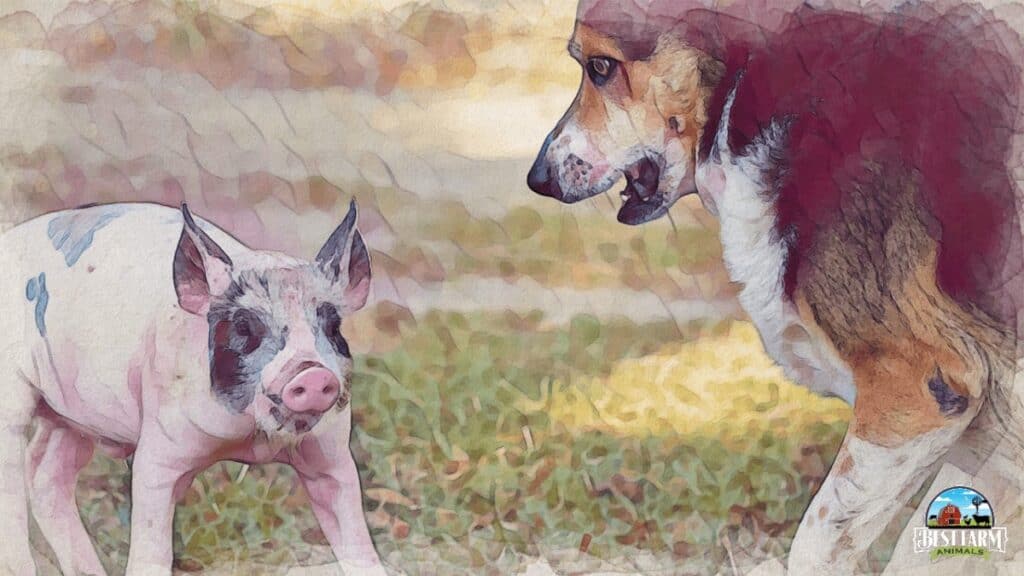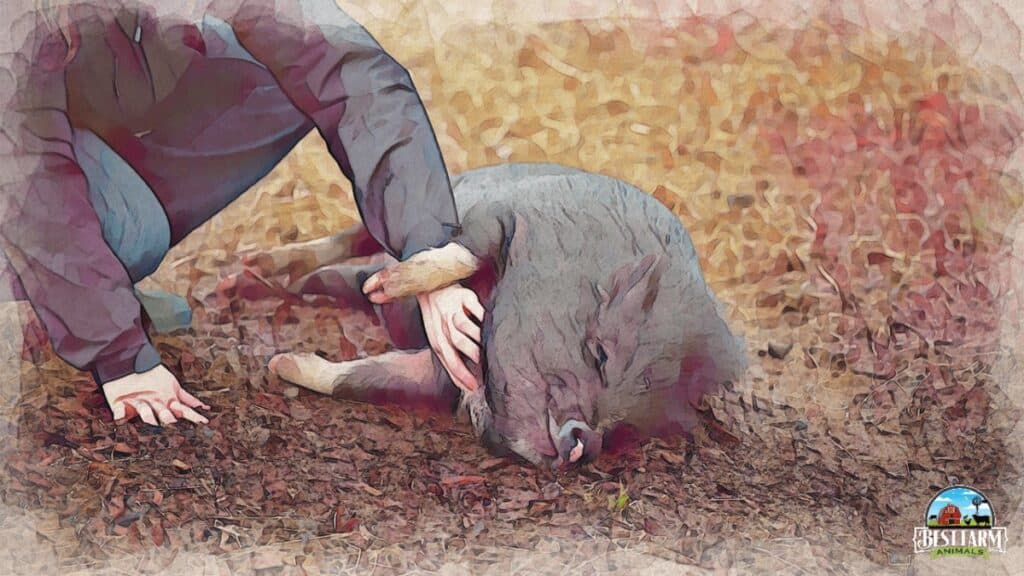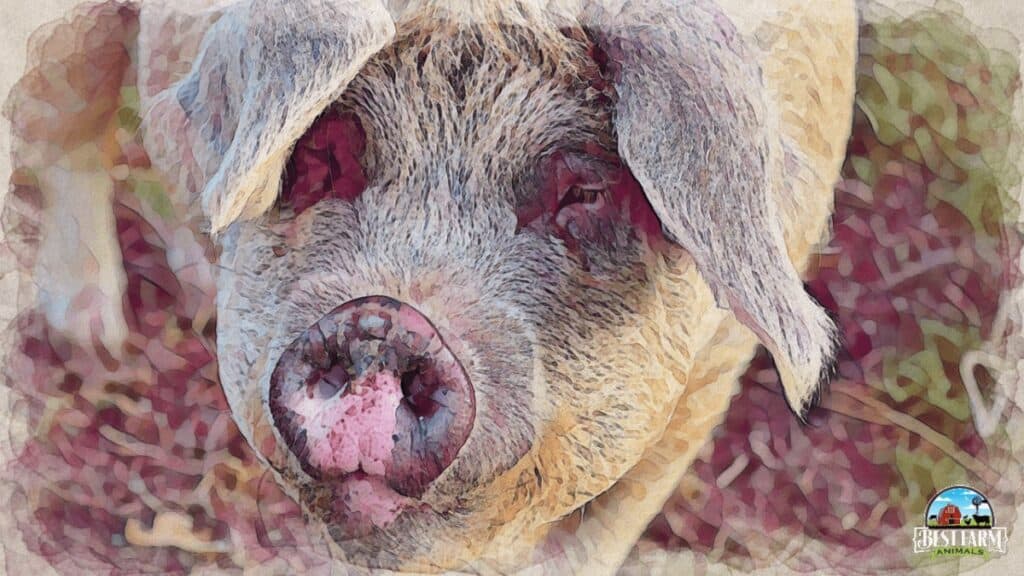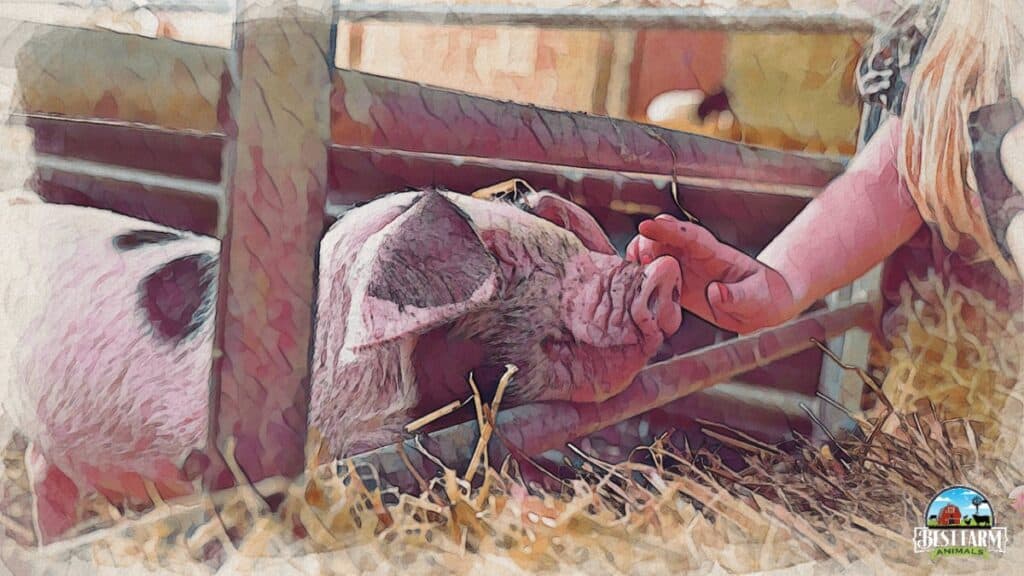My son’s friend was heartbroken last week when his pet pig died unexpectedly. One of the hardest aspects of having pets is having something happen that causes the pet to die.
Since my son also wants a pet pig, I wanted to know how long pigs live and if we can influence it’s length of life. (No parent enjoys it when your kid’s pet dies). If we get a pet pig, I want to make sure it won’t die within a few years.
It turns out that how long pigs live depends greatly on their breed and how they are raised. I’ll explain.

Factors Affecting a Pet Pig’s Lifespan
Numerous factors will affect a pig’s lifespan. As with most animals, disease and illness are prominent determining factors for longevity. So, if a pig gets sick, it is always possible to die prematurely.
Ensuring your pet pig is healthy will extend their lifespan, therefore, it’s important to know the signs of pig diseases so you can help your pig.
Pig Digestive Disorders Affect Pet Pig’s Life Expectancy
A pig is nature’s version of a vacuum cleaner, but that doesn’t help them live longer. They will eat anything. However, the problem is that pigs are not meant to eat everything.
While it may seem suitable for pigs, some food can cause stomach upset and lead to digestive issues.
Pigs will eat almost anything, even if it’s not good for them.
Pigs will eat foods that decrease their health and lower their longevity. A pig’s omnivorous diet can expose them to intestinal bacteria that could be harmful and lead to inflammation of the gut.
This can shorten the pig’s lifespan as indigestion will require treatment with antibiotics and anti-inflammatory medication if needed.
If your pig has managed to swallow something too large to pass through the digestive tract, this can lead to gastric obstruction or a ruptured intestine, proving fatal.
Common pig digestive diseases.
Pigs get digestive diseases that include Colibacillosis and cause early death. Colibacillosis is caused by E. coli bacteria and leads to diarrhea, and salmonella infection, which can cause bloody feces and weakness (and, if not treated, will lead to death).

Pet pigs may not drink enough water to stay healthy.
Dehydration can shorten a pig’s life. Water consumption may be low if pet pigs are kept indoors, leading to constipation if their gut dries out. If constipation isn’t treated quickly, it can lead to rectal prolapse, where sections of the gut protrude from the anus.
This painful condition can cause secondary infections and septicemia and lead to death.
Bone and Muscular Disorders
Overweight, fat, or obese pig’s live for fewer years than healthily-weighted pigs. Pigs are large animals. While not always a large size, most breeds will be heavy, negatively affecting their bones and joints.
Plus, overfeeding or “fattening up” a pig will further exacerbate the issue, leading to chronic lameness, arthritis, and problems with movement.
Lameness in Pigs Reduces Activity and Overall Health
An injured or lame pig won’t move around as much, which can cause their health to decline rapidly. Lameness may result from an injury, such as when your pig tries to jump down some steps or falls and lands badly.
The sheer weight of a large pig will contribute enough force to break front limbs and damage vertebrae in the back. While you can opt to have these injuries repaired, the long-term prognosis regarding their health and longevity is not good.
Arthritis in Pigs
Pigs are also prone to arthritis, which can result from a bacterial infection or degeneration of the bones. In addition, the pig’s excessive weight will further worsen these painful conditions, ultimately shortening their lives.
Poor Hoof Health: Believe it or not, you may need to get your local farrier out to trim your pet pig’s hooves. Pigs experience as much hoof growth as horses do, and while wild pigs self-maintain their hooves with the wear and tear of walking over rough terrain, domestic pigs don’t.
Therefore, your pig’s hooves may crack or become infected if not kept to a short length.
Tetanus in Pigs
Tetanus will shorten a pigs life by killing an infected pig that doesn’t get rapid treatment. The Clostridium tetani bacteria cause another disease that affects pigs, commonly known as tetanus.
Signs of this infection are muscle stiffness and tremors.
Often, this disease can lead to death if left untreated. Therefore, inspect your pet pig for injuries and signs of infectious sites on their body, as this is where the tetanus virus enters their bloodstream. However, annual vaccinations will help prevent tetanus.

Disease and Disorders Affecting the Brain and Spinal Cord
Several nervous system diseases can affect pigs, especially young piglets and cause early death. Constantly monitor your pet pig; you will usually pick up on these early, as your pig will have an elevated temperature or show physical signs of incoordination.
Neurological Diseases in Pigs
If treated early with antibiotics, your pig has a good chance of surviving neurological conditions. However, these diseases often strike fast, and you may find your pet pig deceased in their crate or pen.
Overheating in Pigs
Did you know that overheated pigs have a lower lifespan than pigs with ways to cool themselves down. Other reasons why pigs may die early include overheating.
Pigs can’t sweat, which makes the saying “to sweat like a pig” quite ironic. So, if temperatures exceed 85°F and there is a high humidity factor, pigs won’t be able to control their internal temperature. This means your pig may quite literally boil in their own skin or suffer brain damage due to overheating.
Salt Toxicity in Pigs
Pigs can also suffer from salt poisoning, which is deadly. This condition affects the brain when your pig’s fluid-salt balance is off.
Pigs that have been denied water may suffer this condition, which will cause tremors, disorientation, blindness, and even brain damage.
If your pig has experienced this condition, the only choices are to gradually rehydrate them (which may require your vet to administer an IV solution), or you may need to euthanize your pig.
Respiratory Disease and Disorders
My son was rather shocked when she noticed how wet the pigs at the local piggery’s noses were on her first visit there. Pigs tend toward runny noses, but this can quickly turn to respiratory infections.
Rhinitis in Pigs
Pig Rhinitis can affect your pig’s overall health and length of life. If your piglets start to sneeze, it could indicate the presence of rhinitis-causing bacteria.
I was amazed to discover that this condition could lead to violent sneezing, nose bleeds, and distortion of the pig’s nostrils. Over time, the nostril distortion can affect the pig’s regular breathing.
You can vaccinate against this disease, but the pregnant sow needs to be vaccinated for the piglets to have immunity. As can be expected, chronic rhinitis can cause serious health issues, which may shorten a pig’s lifespan.
Pneumonia in Pigs
Infection of the soft tissue of the lungs can lead to pig pneumonia and shorten the natural life expectancy of your pig. The usual culprits are bacteria that are contracted from littermates, other pigs, and an unclean environment.
Luckily, there is a supportive treatment to relieve this severe infection, and antibiotics may help fight off these bacteria. However, a pig with pneumonia is in danger of dying.
Swine Flu
When the cause of the pneumonia isn’t bacterial but rather a virus, your pig will need to be treated immediately as swine flu is highly contagious and can be passed to humans.
Seek the help of your vet immediately, be careful, and take precautions when handling your pig. Also, wear gloves and wash your hands with medical-grade soap after handling your pet pig.

Skin Conditions That Cause Poor Health
While pigs are naturally itchy and tend toward dry and flaky skin, they can also develop melanomas. These cancerous growths may or may not be malignant.
Usually, they regress independently and don’t affect a pig’s lifespan. However, some melanomas may ultimately lead to early death.
Diamond Skin
Far from being a fancy new skin tattoo, diamond skin, as it’s commonly called, is a contagious skin condition caused by a bacterial infection. In severe cases, this infection can spread throughout the pig, affecting their joints, heart, and lungs. Therefore, death often occurs if the disease runs its course without treatment.
Should you be breeding pigs for slaughter, these affected pigs are not fit for human (or animal) consumption as the bacteria will spread to other animals too. If you suspect your pig has diamond skin, you need to contact your vet and isolate your pet pig to treat them. Administering antibiotics like penicillin is usually effective if the disease is in the early stages.
Urinary Tract Conditions That Could Cause Death
Calculi in Pigs
Calcified stones formed in your pig’s bladder and kidneys. In some cases, it can lead to an early death. Pigs can also develop painful urinary tract infections, leading to obstructions that may require surgical interventions. But having your pet pig screened annually with a urine test will help ensure they remain healthy.
Overconsumption of Water by Pigs
Usually caused by boredom. As a result of too much water in their digestive tract, pigs may urinate too frequently, losing precious nutrients and unbalancing their salt levels.
Kidney Failure in Pigs
Usually affects older pigs. It can also occur if it hasn’t always enjoyed the best care or if they drink too much or too little water. Any of these urinary tract conditions could cause premature death to your pet pig.

Pig Lifespan FAQs
What is the average lifespan of a commercial pig? Commercial pigs have an average lifespan of 3 to 7 months before they are slaughtered. Most commercial pigs are slaughtered at between 6 and 7 months or 25 to 28 weeks. Yorkshire pigs are a hybrid pig raised specifically for it’s meat. While Yorkshire pigs can average a lifespan of 8-10 years, most do not make it that long as they are processed before they are a year old.
How old is a 10-year-old pig in pig years? A ten-year-old pig is 54 years old in pig years. The first year of a pigs life is equivalent to 18 human years, and each year after that is the same as 4 human years. So a 10-year-old pig (in human years) is about 54 years old in pig years. Similar to a 54-year-old human, a 10-year-old pig is a little over half of it’s expected lifespan.
Do pigs make good housepets? Mini pigs can make great housepets if trained and socialized from a young age. Mini pigs are gaining popularity as house pets. They are smarter than dogs and can be litter trained. Pigs can learn tricks, bond with human owners, and become a beloved part of the family.
How long do pigs live in captivity? Pigs raised in captivity, either as a pet or as a breeding pig often live 5-10 years, although some captive pigs can live up to 23 years. The breed of the pig will impact how long it will live with potbellied pigs living the longest of any pig breed. Teacup pigs often only live between 5-10 years because of their compromised health.
Conclusion
It’s great to know that we can get a pet pig that can live a long healthy life. Check out 5 steps you can take to increase your pig’s lifespan. Ultimately we decided to wait and see if my son’s interest in a pet pig lasted before we committed to a pet pig that would need care for as much as two decades.
References
Public Med Central
Arthritis Induced by Dietary Factors
MSD Vet Manual
Potbellied Pigs disorders and diseases
My Most Used Pig Supplies
This list contains affiliate products. Affiliate products do not cost more but helps to support BestFarmAnimals and our goal to provide farm animal owners with accurate and helpful information.
Purina Pig Chow will last well (or Mazuri is popular, but I haven’t tried it), and the stainless steel non-skid bowls that will help keep the mess down.
A pig blanket to keep her warm. This one also has bright colors and helps to provide rooting without the destruction.
Pig Harness for walking and handling your pig. There are a lot to choose from, but this one is pretty easy to use. If you want one that has a separate leash, this looks like a good one.
A large crate for keeping her safe in your house at night and when you leave the house. This is essential. You’ll also want a litterbox, and I like mine with a lid for nighttime. Pine shavings are best, and you may be able to find them in larger quantities locally.
When you have accidents, Odoban will help eliminate odors. When you are potty training, these floor pads work great for keeping your house clean while training her to go in certain places.
You’ll also want an outdoor house to keep her warm when she gets outside time, an essential part of her development.
Dewormer- Ivermectin is the primary dewormer I use, although I do rotate with a non-ivermect ingredient once so that the worms don’t get immune to it.

